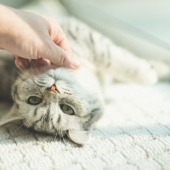Cats who remain indoors are safe from the outside world’s many hazards. However, constantly living in the same environment can make them more vulnerable to boredom, obesity and behavioural issues. In addition to having regular play sessions, here are a few ways to make your house more exciting for your cat and to help keep them mentally stimulated and physically fit.
1. Provide cat-friendly vertical spaces.
Cats feel safe high up. Elevation gives them a better view of their surroundings and keeps them out of reach of predators – even imaginary ones. Consider purchasing a tall cat tree or installing a series of empty shelves to create a climbing route. Or you could clear some space in your bookshelf and move fragile objects elsewhere.
2. Use windows as endless entertainment for your cat.
Windows keep your cat mentally engaged in more ways than one, whether birdwatching, looking at squirrels and other wildlife (including people) or just lounging in the sun. Installing a window perch or hammock in front of a fantastic view provides your cat with many benefits of the great outdoors while remaining safely inside. Consider setting up a bird feeder just outside for added entertainment value.
Does your house cat have mobility issues?
Most healthy cats can jump up to six times their height, about 4 to 5 feet for adults. Tell your veterinarian if your cat experiences difficulty jumping onto perches or shelves below this height. Osteoarthritis, a degenerative joint disease, is prevalent in felines (affecting 1 in 5 cats over the age of 2). Joint health can be supported with chewable supplements such as Flexadin.
3. Offer multiple lounging spots… and move them around.
Most house cats enjoy hiding, resting and sleeping in places where they feel safe and comfortable. Set up beds, cushions and an open-door carrier in different locations around your home to provide your feline friend with multiple options. Put some in darker, quieter areas for when your cat wants to be left alone, and others close to living areas where they can be part of your household’s life. If your pet stops using certain resting spots, move them elsewhere to encourage your cat to explore new areas.
4. Hide food around the house.
Because cats are natural hunters, feeding from a bowl isn’t particularly challenging for them. Appeal to their instincts by hiding part of their food in the same place for a few days. Then hide some a little further. Once your cat becomes used to searching for their food, you can start concealing some in various areas of your home, encouraging your pet to hunt their surroundings for hidden snacks.
5. Provide scratching posts and scratchable surfaces.
Cats have a normal, instinctive need to scratch things. They do so to trim their nails, to stretch their muscles, to mark their territory by leaving their scent and to express certain emotions, such as stress. To help prevent your cat from destroying your furniture and valuable carpets, make sure to direct your pet’s attention to suitable scratching surfaces. Reward them with treats and toys to reinforce this behaviour.
You can install store-bought scratching posts, but don’t be afraid to experiment with other materials such as flat cardboard, an old rug or even leftover wood planks and posts. Watch which textures your cat seems to prefer.





